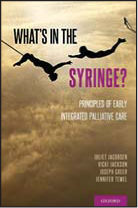Translate this page into:
Book Review: What’s in the Syringe? Principles of early integrated palliative care
[To cite: Vihari J, Sowmya P, George KR, Shabarish HR. What’s in the Syringe? Principles of early integrated palliative care (Book Review). Natl Med J India 2023;36:396. DOI: 10.25259/NMJI_848_2023]
What’s in the Syringe? Principles of early integrated palliative care. Jennifer Temel, Joseph Greer, Juliet Jacobsen, Vicki Jackson. Oxford University Press, Oxford. 192pp, ₹3670. ISBN 978–019–7525–173.

This is a comprehensive and insightful guide that explores the critical principles of early integrated palliative care. Written by a group of experts in the field, it offers a detailed analysis of the crucial elements that go into providing good palliative care and emphasizes the need for early integration and multidisciplinary cooperation. We highlight the book’s accomplishments in clarifying the fundamentals of palliative care, its applicability to the current state of healthcare, and a few places where it may be improved.
The authors delve into the complex world of palliative care, demystifying its foundations and highlighting its crucial role in enhancing the quality of life for patients with severe conditions. To provide readers a rich tapestry of knowledge that is both instructional and thought-provoking, the book deftly blends theoretical understandings with practical tactics.
Dr Juliet Jacobsen, an interventionalist for the Cancer Outcomes Research Team’s palliative care studies, contributed to defining early integrated palliative care. Dr Jackson, a Palliative Care physician, developed the theoretical basis for the early integrated palliative care model. Dr Greer, a Clinical Psychologist, has worked to evaluate the impact of the early integrated palliative care model on outcomes for patients with advanced lung cancer. Dr Temel pioneered outpatient palliative care for advanced lung cancer patients, integrating it with oncology care.
The book’s unrelenting dedication to understanding the complexities of early integrated palliative care is one of its most remarkable features. The writers skilfully lead readers through various components of palliative care, showing how it goes beyond pain relief to consider a patient’s emotional, social and spiritual well-being. The chapters on communication and shared decision-making stand out in particular because they lay a strong emphasis on the necessity of genuine and open communication between medical professionals, patients and their families.
The book’s emphasis on cross-disciplinary collaboration is another feature. It highlights how a comprehensive approach integrating expertise from the medical, nursing, psychiatric and spiritual sectors may improve a patient’s experience and lessen suffering. The inclusion of relevant case studies and practical examples helps to bridge the gap between theory and practice and broadens the book’s utility.
When the global healthcare environment is rapidly changing, putting an emphasis on early integrated palliative care is relevant and essential. As the population ages and chronic illnesses increase in prevalence, a holistic approach to patient care is important. This book equips healthcare professionals, educators and students with the information and tools they require to confront these issues head-on and promote a paradigm change that is patient-centred.
Although there are a few places where it may be reinforced, the book does a great job of laying out the principles of palliative care. Given the variety of patient groups seen in today’s healthcare settings, further study on cultural competency (ability of healthcare providers to understand, respect and effectively navigate the cultural beliefs, practices and preferences of diverse patient populations) and its function in the provision of palliative care may be beneficial. It ensures that care is tailored to an individual’s cultural background, enhancing communication and patient outcomes. Additionally, readers may gain insight into the future of patient assistance via the introduction of cutting-edge technical developments and their integration into palliative care (integration of telehealth platforms that enable patients and families to access consultations, support and symptom management remotely). For example, virtual reality systems might be used to provide immersive experiences that promote relaxation and pain relief for patients receiving palliative care at home.
The book’s analysis of challenging topics might also gain depth through a more complete consideration of the ethical concerns surrounding palliative care, such as advance care planning and end-of-life decision-making. Finally, a deeper analysis of the challenges and opportunities associated with implementing early integrated palliative care in various healthcare systems across the world will offer a broader perspective.
This book is a useful resource for demystifying the complicated world of palliative care. Due to its thorough investigation of fundamental concepts, commitment to interdisciplinary collaboration, and applicability in contemporary healthcare, it makes a noteworthy contribution to the literature. With a few additions to address cultural competence, technological advancements, ethical considerations and global perspectives, the book has the potential to become an even more important resource for healthcare professionals dedicated to improving the well-being of patients dealing with serious illnesses.




